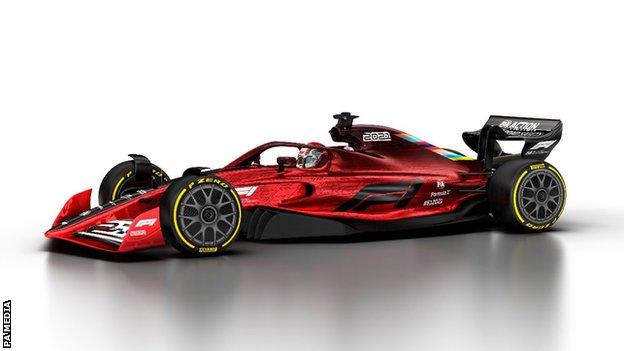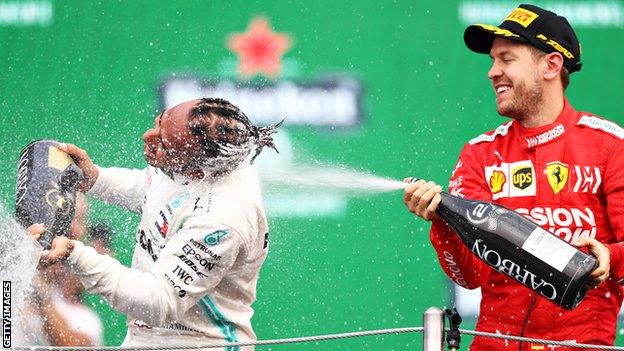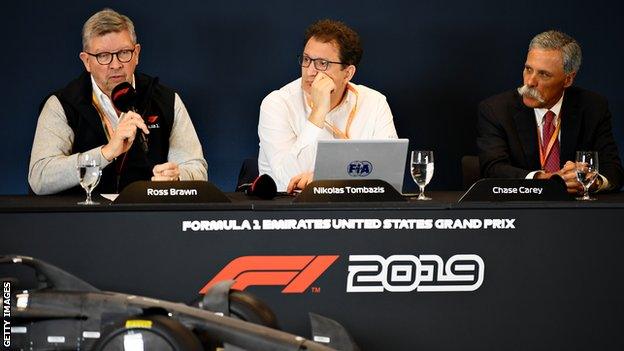Formula 1: New technical, sporting & financial rules for 2021 revealed
- Published

Formula 1 have released a prototype with the 2021 regulations implemented
Plans to revolutionise Formula 1 in 2021 have been revealed by the sport's bosses on the eve of the US Grand Prix.
New technical, sporting and financial rules will be introduced to try to make racing closer and more dramatic.
Jean Todt, president of governing body the FIA, said the rules had been unanimously approved by the World Council, F1's legislative body, on Thursday.
Key changes are a new aerodynamic concept and a $175m (£135m) budget cap.
The three leading teams - Mercedes, Ferrari and Red Bull - have opposed the new rules and believe they are fundamentally flawed.
But Todt described it as "a very special day for our sport", adding: "The goal is to have a closer championship and more unpredictable [racing] on track."
Ferrari had opposed the rules, and had the option to veto them within five days. But that prospect has now been removed after they voted for them in the World Council.
In a statement the team said: "What has been voted is a good starting point. We'll work together to improve them even further."
What is happening to the cars?
There will be a major change to the way F1 cars produce their performance from aerodynamic downforce.
Under the new rules, cars will generate a far greater proportion of their overall downforce from under the car, and there will be a significant reduction in the number of external shapers around the bodywork.
The idea is to reduce the effect of 'dirty air' from a car in front on one trying to follow behind.
The FIA's head of single-seaters, Nikolas Tombazis, a former Ferrari chief designer, said that while in 2019 a car following within one car length of another retained only 55% of its total downforce, in 2021 that number should be 86%. At three car lengths, in 2019 it is 68% and in 2021 95%.
Countering claims that the cars will all look the same under the 2021 rules, Tombazis said there were a number of areas where cars could be differentiated, including the nose, front wing, side pods, engine cover, brake ducts and rear wing.
The cars will have less downforce than this year and will be about 25kg heavier, and they are expected to be about three seconds a lap slower.
Brawn said: "To put that into perspective, that is about the performance of a 2016 car."
He said he never understood the reasons for increasing the cars' performance in 2017. "The cars are very quick now but they are not raceable," Brawn said.

Sebastian Vettel won his four world championships with Red Bull before regulations changed in 2014 to introduce turbo-hybrid engines. Since then, Lewis Hamilton won four of his five world championships
What about the budget cap?
The FIA and F1 confirmed plans for a $175m budget cap had been accepted from 2021.
But there will be a number of exemptions, including driver salaries, remuneration of the three best-paid executives and all marketing costs.
Todt said: "This is still a high figure, but we consider it a first step."
The cost cap is not as controversial as the technical regulations - all teams committed to it in July and nothing has changed since.
The sanctions for breaching the financial regulations will be sporting penalties.
F1 sporting boss Ross Brawn said: "If you breach these, you will be losing your championship. There are serious penalties.
"It is absolutely essential for the future of F1 that we control spending.
"We tried to capture the areas that make a difference between teams, where they can gain a competitive advantage."

(L-R) F1 technical director Ross Brawn, FIA's head of single-seaters Nikolas Tombazis, and F1 chief executive Chase Carey, unveiled the new regulations on the eve of the US Grand Prix
What about the tyres?
The F1 drivers have been saying for some time that one of the major causes of difficulty in racing is the tendency of the Pirelli tyres to overheat when pushed hard or when a car is following another.
Pirelli has been given a new set of criteria around which to develop their tyres as they try to make them less heat-sensitive.
Tombazis said: "We are fully aware tyres are equally important for races. We have been researching this with Pirelli. There is a new target letter, setting out their key objectives. That is not part of the regulations. Pirelli are carrying out some research on the tyre constructions. There should see some gains for 2020 and 2021.
"Cars have developed a lot more downforce in recent years and there has been progress from last year to this year and we feel there will be [further] progress.
"Their contract requires Pirelli to do their best endeavour, so there are no penalties as such, but it is in everyone's interest to tackle it. Hopefully this will ease these concerns."
Brawn added: "In fairness to Pirelli, they have had so many diverse inputs, they have struggled to have clarity on what they can focus on. We have changed the objectives. We are trying to give them more clarity on what F1 really needs and I think they have been responding quite well."

Ferrari have within their contract a right of veto of any rule changes they believe to be counter to their interests
What about engines?
F1 will stick with the existing 1.6-litre V6 turbo hybrids, despite initial plans to change them when new owners Liberty Media took over the sport at the start of 2017.
Tombazis said these were "the most efficient engines on the planet in terms of conversion of the energy that goes into them to power at the rear wheels, and we felt changing that would be a step backwards."